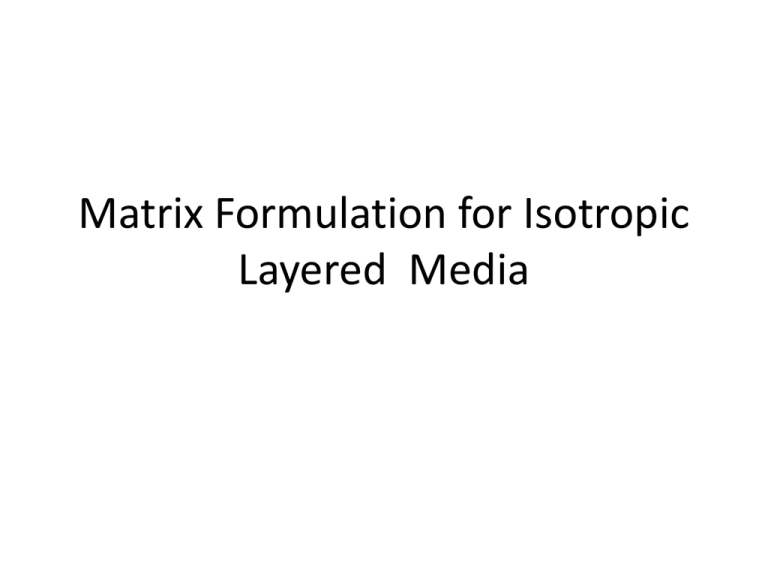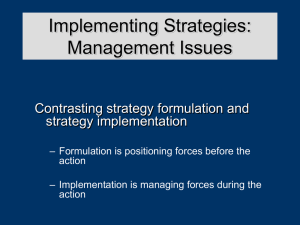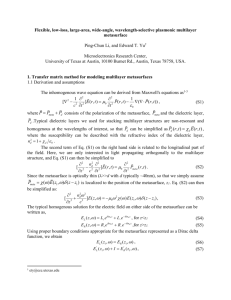Matrix Formulation for Isotropic Layered Media
advertisement

Matrix Formulation for Isotropic Layered Media 2Χ2 Matrix Formulation For a Thin Film • The dielectric structure is described by • The electric field can be written as 2Χ2 Matrix Formulation For a Thin Film • The electric field E(x) consists of a right-traveling wave and a left-traveling wave and can be written as • Let A(x) represent the amplitude of the right-traveling wave and B(x) be that of the left-traveling one. 2Χ2 Matrix Formulation For a Thin Film • To illustrate the matrix method, we define 2Χ2 Matrix Formulation For a Thin Film • If we represent the two amplitudes of E(x) as column vectors, the column vectors are related by 2Χ2 Matrix Formulation For a Thin Film • D1, D2 and D3 are the dynamical matrices and given by • Where α = 1,2,3 2Χ2 Matrix Formulation For a Thin Film • The matrices D12 and D23 may be regards as transmission matrices that link the amplitude of the waves on the two sides of the interface and are given by 2Χ2 Matrix Formulation For a Thin Film • The expression for D23 are similar to those of D12. • The equations can be written formally as 2Χ2 Matrix Formulation For a Thin Film • The amplitudes are related by 2Χ2 Matrix Formulation for Multilayer System • The multilayer structure can be described by 2Χ2 Matrix Formulation for Multilayer System • The electric field distribution E(x) can be written as 2Χ2 Matrix Formulation for Multilayer System • Using the same argument as in Section 5.1.1, we can write 2Χ2 Matrix Formulation for Multilayer System • The matrices can be written as 2Χ2 Matrix Formulation for Multilayer System • The relation between written as with the matrix given by can be Transmittance and Reflectance • If the light is incident from medium 0, the reflection and transmission coefficients are defined as Transmittance and Reflectance • Using the matrix equation and following definitions, we obtain • The reflectance and transmittance are Example: Quarter-Wave Stack • We consider a layered medium consisting of N pairs of alternating quarter-waves with refractive indices n1 and n2, respectly. Let n0 by the index of refraction of the incident medium and ns be the index of refraction of the substrate. Example: Quarter-Wave Stack • The reflectance R at normal incidence can be obtained as follows: The matrix is given by • The propagation matrix for quarter-wave layers(with φ=(1/2)π) is given by Example: Quarter-Wave Stack • By using Eq.(5.1-23) for the dynamical matrices and assuming normal incidence, we obtain, after some matrix manipulation, Example: Quarter-Wave Stack • Carrying out the matrix multiplication in Eq.(5.2-7) and using Eq. (5.2-5), the reflectance is • Reflectance of a Quarter-Wave Stack General Theorems of Layered Media • The matrix elements Mij satisfy the relations provides n1, n2, n3,and θ1, θ2 are real. • The propagation matrix Pl is a unimodular matrix General Theorems of Layered Media • The matrix product is merely a transformation of the propagation matrix and is also unimodular. Thus, the determinant of the matrix M is very simple and given by Left and Right Incidence Theorem • For a given dielectric structure defined by Eq.(5.1-16), the reflection and transmission coefficients defined by Eqs.(5.2-1) and (5.2-2), respectively, may be considered as function of β: Left and Right Incidence Theorem • Let r’ and t’ be the reflection and transmission coefficients, respectively, when light is incident from the right side with the same β. Left and Right Incidence Theorem • Let T and T’ be the transmittances of the layered structure when light is incident from the left medium and right medium. These two transmittances are given by • Using Eq.(5.3-8) and the expression for |M| in Eq.(5.3-3), we obtain Principles of Reversibility • For the case of a dielectric multilayer structure with real index of refraction, the functional relations between these four coefficients (r, t, r’, t’) can be obtained Conservation of Energy • In the case when all the layers and the bounding media are pure dielectrics with real n, the conservation of energy requires that R+T=1









